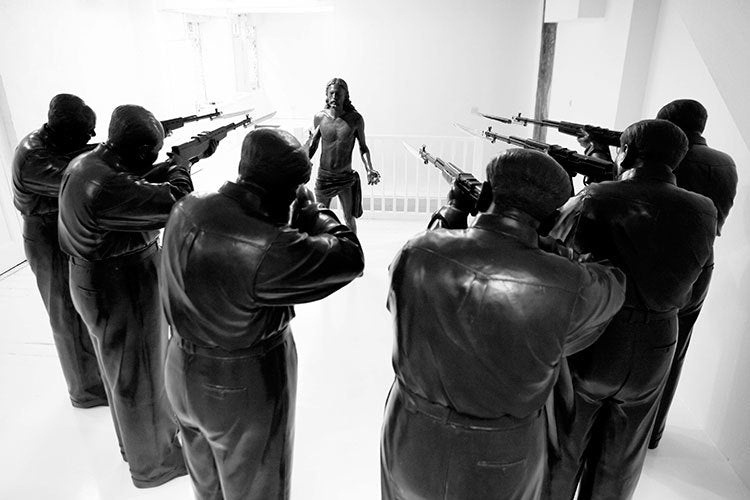
SHOWstudio's exhibition 'Death' was centred around the Gao Brother's seminal work, 'The Execution of Christ.' A grandiose, life size, bronze sculpture, the piece is an appropriation of Manet's 'The Execution of Emperor Maximilian'. In true political pop fashion, the firing squad are re-made as eight life size Chairman Maos, and the figure of the emperor is replaced with a portrayal of Jesus. It references firstly the oppression of organised religion, in particular Christianity under Mao's regime and during the Cultural Revolution, but also the Gao's own experience of losing their father when he was arrested and executed during this period.
Of all the themes this work references, the exhibition focused specifically on the moment of liminality the sculpture exists in. At its most dramatic, a space between life and death, but also between presence and absence, the secular and the religious. As Jesus stares down the barrels of six rifles, death is present as a kind of threshold in which there is this potential for transition, rather than a final or end point.
Claire Morgan's featured work, 'Heart of Darkness' also attempts to capture the elusive nature of time. As though reversing the inevitability of change and entropy, this macabre mobile captures a swarm of bluebottles in a frozen moment of perfect symmetry. Each fly, fixed in place with lead, hangs in a mathematically formulated, three dimensional grid which becomes increasingly dense towards its centre. Morgan asserts an intense control on this normally chaotic scene and in doing so confronts her viewer with a stark collision of nature and culture. These creatures, so closely associated with death, detritus and decay and so crucial to decomposition and regeneration are harnessed and stratified through Morgan's rigorous handling.
Taking up a pose reminiscent of early Christian iconography and bestowed with a pair of angelic wings, Nick Knight presented celebrity as deity in his depiction of Kate Moss. Pulling on the associations of angels as messengers of both life and death, Knight referenced memorializing statuary with Moss immortalized in a free standing and entirely accurate effigy. The beautiful sarcophagus, made from a 3D scan of the icon, acts as a profoundly moribund portrait of a woman who seems to be frozen in time inside the skin of her own statue.
Together these three monuments forced death from the periphery and asked the audience to encounter and engage the inevitability of dying. In each piece, death lingers; hovering as a subject in a state of becoming. In turn, we engage with the continuing cycle where death is negotiated and harnessed within culture.